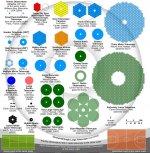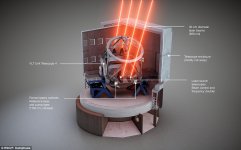I think we in Concord that the JWST is a Cassegrain.
Still an incomplete sentence you English speakers! 😎To be in concord: To be in a state of agreement.
Look it up you non-English speakers! 😛
And drop those inappropriate capital letters, Steve!
I'll forgive him the "are"s
Or, I'll forgive him, the "are"s.
Verbal joke. With apologies to Steve.
Or, I'll forgive him, the "are"s.
Verbal joke. With apologies to Steve.
Proof? Don't mean to be over your head, it's just incidental.
Who am I to judge?
What you just said. 😕
perhaps you should reread your own postsWhat you just said. 😕
perhaps you should reread your own posts
I do that constantly. They're the ones that make the most sense! 😛
Haha - dont go by the UD... just tried to out a dog sound.... 🙂Woff : When a nasty smell blankets an entire area. (Urban Dictionary)
WTF!!!! 😉
//
Looks like the ESO VLT will be the biggest of them all. There’s a bit of competition between the US and Europe on these ‘scopes. The VLT mirror segments are being cast in Germany and the polishing done in France. The OWL, another European joint venture, had a proposed 100 metre mirror (😮) but was halted because the costs ballooned to c. €1.5 billion. Seems 30-40 metres for $200-300 million is the sweet spot. After this it gets really expensive.TNT, you are like a dog that won't let go of a bone! Shame on you. I have known exactly how the JWST diffraction works all along. It is the GMT that made me think and research.
Very good video, Bonsai. It is interesting that we think that the expansion of the Universe started about 5Bn years ago when expansive dark energy grew stronger than dark matter influence in most parts of the Universe. Except in our local Virgo cluster of galaxies where we have lots of mass holding it together. There is evidence that some local globular clusters around our Milky Way Galaxy have very little datk matter.
FWIW, the GMT is a segmented concave secondary Gregorian telescope. Am unsure about the JWST which has a single circular secondary. A Cassegrain has a convex hyperbolic secondary mirror. A Newtonian, a flat secondary that images sideways.
My local charity shop has a 70mm refractor for sale with a good tripod and the bigger standard 1.25" eyepieces. £40. Seems good. Has star maps too.
That's was 13 off-topic posts on the trot! 🙄
We are discussing telescopes IIRC... Well done Bonsai, for getting back on topic.
To further this end I have rustled up a Giant Magellan Telescope fishcake lunch today:

They don't teach that in school! 😎
We are discussing telescopes IIRC... Well done Bonsai, for getting back on topic.
To further this end I have rustled up a Giant Magellan Telescope fishcake lunch today:
They don't teach that in school! 😎
What they need is to be polished ‘off’.They need a bit of polishing Steve. And then a good coating 😊

Last edited:
Looks like the ESO VLT will be the biggest of them all.
Will be?
You must be referring to the Very Large Telescope, which is run by the European Southern Observatory.
This comprises four 8.2 m reflecting telescopes which can be linked together, if required, to form a giant virtual telescope.
The facility has been operational for over 20 years.
It would appear that the largest, single, working, optical telescope is the GTC (Gran Telescopio Canarias) which has a primary mirror of 10.4 m diameter and has been operating since 2009.
Both these telescope systems are shown on Steve's handy chart.
Attachments
I'll bet on mobile posting without the "where are those d*mn glasses again" thingies...I'll forgive him the "are"s
Or, I'll forgive him, the "are"s.
Verbal joke. With apologies to Steve.
//
I meant ELT!Will be?
You must be referring to the Very Large Telescope, which is run by the European Southern Observatory.
This comprises four 8.2 m reflecting telescopes which can be linked together, if required, to form a giant virtual telescope.
The facility has been operational for over 20 years.
It would appear that the largest, single, working, optical telescope is the GTC (Gran Telescopio Canarias) which has a primary mirror of 10.4 m diameter and has been operating since 2009.
Both these telescope systems are shown on Steve's handy chart.
I get to later see posts I made without my specs on. Embarrassing. Well, that's my excuse anyway! Then the damn spell checker always thinks it knows better!I'll bet on mobile posting without the "where are those d*mn glasses again" thingies...
//
I've been looking further into adaptive optics in order to discover why ground-based telescopes shine lasers into the sky.
If there's a bright star in the field of view, the way its shape is changing due to atmospheric turbulence is monitored and the information used to adapt the telescope's mirror to compensate for the turbulence.
However, a sufficiently bright "guide star" is only present in the field of view for about 10% of the whole sky.
Sky coverage can be increased by the generation of an "artificial star" using a powerful laser beam which is shot from the telescope into the sodium layer of the atmosphere, high above where the turbulence occurs. 😎
If there's a bright star in the field of view, the way its shape is changing due to atmospheric turbulence is monitored and the information used to adapt the telescope's mirror to compensate for the turbulence.
However, a sufficiently bright "guide star" is only present in the field of view for about 10% of the whole sky.
Sky coverage can be increased by the generation of an "artificial star" using a powerful laser beam which is shot from the telescope into the sodium layer of the atmosphere, high above where the turbulence occurs. 😎
Attachments
just tried to out a dog sound.... 🙂
I guess we're both barking mad! 🤪
Sure, help Steve out but kick Spike to the curb, eh.I guess we're both barking mad! 🤪
@TNT...it's 'Wuff' with a 'u', not 'o'.
Pfft! 🙄
- Status
- Not open for further replies.
- Home
- Member Areas
- The Lounge
- What is the Universe expanding into..


